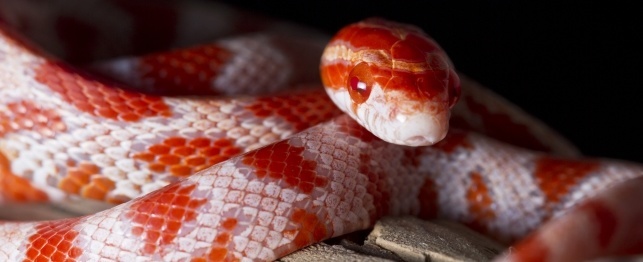

Reptiles
It's easy to see why corn snakes are the most popular pet snakes. Also known as the common or red rat snake, they generally are placid and easy to care for. They adapt well to captivity. They generally are healthy if provided with good basic care and can live into teenaged years.
So if you're thinking about buying a corn snake, here are some facts about this reptile.
Colors vary, but one common variety is a gray- to tan-colored reptile with a series of large red saddles, with black edges, along its back. Its underside is checkered black and white, but there is a great deal of regional variation. Degrees of orange to red also may be seen. The first marking on the back extends as a point on top of the head and an orange to red line extends from above the snout to below the angle of the jaw, through the eye.
Corn snakes are medium-sized, rarely exceeding a yard or so in length. Large adults seldom exceed a kilogram (2.2 pounds) in weight.
Corn snakes are generally active, and many are accomplished climbers, inhabiting forest, scrub and grasslands. They require periods of seclusion in a hide-out, especially after feeding. They appear completely indifferent to handling, although this should be avoided for two to three days after feeding to prevent regurgitation. This snake generally accepts food at any time of day or night and can be quickly adjusted to the owner's routine. Their climbing ability makes them escape artists. Very young corn snakes can even squeeze between sliding glass doors, so beware.
Corn snakes seldom bite. The most hostile reaction that one can expect is defecation on a rough or careless handler. All snakes can excrete salmonella and therefore it is important to wash your hands routinely and to supervise all child-snake interactions.
Note: When the snakes are shedding, they can be temperamental, so it's best to limit handling then.
An adult corn snake should be kept in a vivarium that is at least 4.5 feet long, and 1.5 feet wide and deep. It should have sliding glass doors for good access and ventilation grills to facilitate air flow. You should not reduce ventilation in an effort to artificially maintain temperature and humidity. Heating can be provided by an under-tank heat mat or an overhead ceramic or infrared heater. All heaters must be controlled by a thermostat and screened to prevent snake-heater contact that invariably results in horrendous burns. A daytime temperature range of 75 to 85 degrees Fahrenheit, with a basking area of 85 to 90 degrees, should be lowered to 70 to 75 degrees at night.
Corn snakes, like most snakes, do not have any special lighting requirements. Maintaining a 12-hour photoperiod using small fluorescent strip lights or external room lights is adequate. During hibernation periods, these snakes are often not illuminated at all, or are subject to the natural lighting of the room.
Artificial turf or paper toweling should be used to cover the floor. Several hide-outs or retreats (small cardboard boxes etc.) are essential. A stout, well-secured clean branch can add to the attractiveness of the set-up and provide climbing exercise.
It is important to prevent excessive humidity and moisture as skin infections are likely in such situations. A warm, dry and well-ventilated vivarium is optimal. Fresh water should always be available in a large, heavy bowl that is sufficient for bathing and yet cannot be overturned.
Corn snakes readily accept defrosted-frozen prey, mostly rodents, from birth. In general, the diameter of the prey should not exceed the snake's girth. Frozen-thawed mice are preferred. Anorexia is rare and should be considered a sign of illness, unless the snake is hibernating, breeding or about to shed.
Corn snakes adjust so well to captivity that many non-breeding adults restricted to the vivarium and fed weekly become obese. Therefore feeding intervals of four to five days for neonates, five to seven days for juveniles and seven to 14 days for non-breeding adults are recommended. Breeding adults, especially females, may need to be fed every week to reclaim lost body condition after hibernation and breeding.
Corn snakes reportedly can be bred when they are 1 year old, but it's better to wait until they are 2 or 3. Successful reproduction often requires a period of cooling or hibernation depending upon the geographic origin. Keeping the vivarium at 50 to 68 degrees for eight to 12 weeks without food is generally sufficient to induce mating behavior upon a return to the normal temperature range.
Keeping groups of males and females apart during much of the year and bringing them together for breeding improves mating success, but single male-female pairs often are productive.
Females usually lay eight to 26 leathery eggs between March and June. Second clutches in late summer are not uncommon.
Artificial incubation at 82 degrees and 60 percent humidity results in an 80 percent to 100 percent hatch rate after 55 to 73 days. The young measure 8 to 11.2 inches (20 to 28 centimeters) in length and usually will accept pink mice after their first shed, usually within three to seven days of hatching. Care of the neonates essentially is the same as for adults, except that close attention must be paid to avoid escapes, and feeding requires more frequent offerings of smaller mice starting with pinkies, then fluffs, sub-adult and finally adults.
Breeding has been so successful that it is has resulted in self-sustaining captive populations throughout North America and Europe. Frequent breeding also has driven down the cost of these snakes, except for the more highly prized color variants.
Copyright © 2005-2016 Pet Information All Rights Reserved
Contact us: www162date@outlook.com